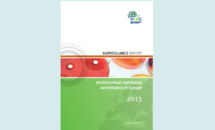Antimicrobial resistance surveillance in Europe 2013
This report presents antimicrobial resistance data for seven microorganisms of major public health importance: Escherichia coli, Klebsiella pneumoniae, Pseudomonas aeruginosa, Acinetobacter species, Streptococcus pneumoniae, Staphylococcus aureus, and Enterococci. For 2013, data were reported by 30 countries and the report also presents trend analyses for the period 2010–2013.
Publication data and a summary of the report are available below.
Executive Summary
The results presented in this report are based on antimicrobial resistance data from invasive isolates reported to EARS-Net by 30 EU/EEA countries in 2014 (data referring to 2013), and on trend analyses of EARS-Net data reported by the participating countries during the period 2010 to 2013.
The antimicrobial resistance situation in Europe displays large variations depending on bacteria, antimicrobial group and geographical region. For several antimicrobial group and bacterium combinations, a north-to-south and west-to-east gradient is evident in Europe. In general, lower resistance percentages are reported by countries in the north and higher percentages reported by countries in the south and east of Europe.
Overall, the most concerning trends in Europe in 2013 were related to the occurrence of resistance in gram-negative bacteria (Escherichia coli, Klebsiella pneumoniae, Pseudomonas aeruginosa and Acinetobacter species). For E. coli and K. pneumoniae, a continuous increase in resistance to key antimicrobial groups was noted. A majority of the isolates reported to EARS-Net in 2013 was resistant to at least one of the antimicrobial groups under surveillance, and many of these showed combined resistance to third-generation cephalosporins, fluoroquinolones and aminoglycosides. Over the last four years (2010 to 2013), resistance to third-generation cephalosporins in K. pneumoniae and E. coli increased significantly at EU/EEA level, as well as in many of the individual Members States. Many of the isolates resistant to third-generation cephalosporins were ESBL-positive and showed resistance to additional antimicrobial groups. In addition, resistance to fluoroquinolones, aminoglycosides and carbapenems, as well as combined resistance to fluoroquinolones, third-generation cephalosporins and aminoglycosides increased significantly at EU/EEA level for K. pneumoniae, but not for E. coli.
Interestingly, there was a decrease in fluoroquinolone resistance in P. aeruginosa, which was seen for both the EU/EEA population-weighted mean percentage as well as in the trends for several individual countries, whereas fluoroquinolone resistance increased in K. pneumoniae.
While the EU/EEA population-weighted mean for carbapenem resistance was 8.3 % for K. pneumoniae, carbapenem resistance remained very low in E. coli (0.2 %). However, five countries reported trends of increasing carbapenem resistance in E. coli in 2013; four of them belonging to the countries with the highest levels of resistance. Carbapenem resistance and resistance to multiple antimicrobial groups were also common in Pseudomonas aeruginosa and Acinetobacter spp. isolates. Data for polymyxin resistance (colistin and polymyxin B) were limited but indicated the presence of polymyxin resistance in all gram-negative bacterial species included in EARS-Net reporting, especially in countries with already high levels of carbapenem resistance.
Resistance trends for gram-positive bacteria showed a more diverse pattern across Europe. For meticillin-resistance in Staphylococcus aureus (MRSA), the population-weighted EU/EEA mean has decreased significantly over the last four years. The decrease has, however, been less pronounced compared with the previous four-year period. The trends for Streptococcus pneumoniae were generally stable, but with large inter-country variations in the percentage of resistant isolates. Macrolide non-susceptibility in S. pneumoniae was, for most countries, higher than the percentages for penicillin-non-susceptibility.
For enterococci, the population-weighted EU/EEA mean percentage for vancomycin resistance in E. faecium increased significantly between 2010 and 2013. The decrease in the percentage of high-level aminoglycoside resistant E. faecalis observed in a number of countries in recent years continued in 2013, although the populationweighted EU/EEA mean showed no significant change.
Download

Publication data
Data
Antimicrobial resistance surveillance in Europe 2013 data
This downloadable zip folder contains tables and maps presenting data collected as part of the report: Antimicrobial resistance surveillance in Europe 2013.




